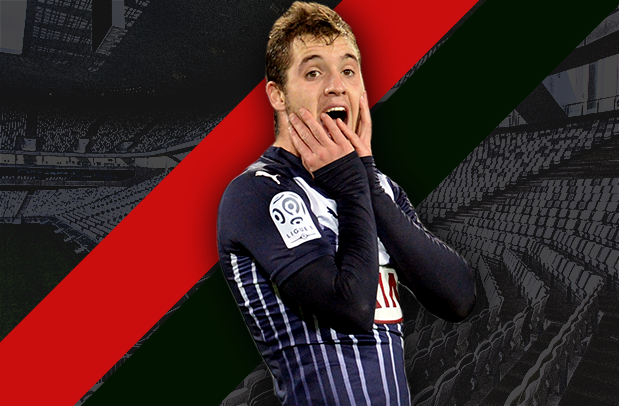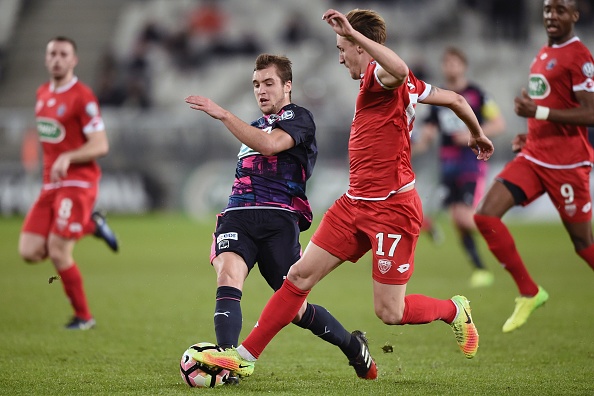Eric Devin writes a comprehensive scout report on Valentin Vada, Bordeaux’s exciting young midfielder
Born in Argentina’s interior in the province of Santa Fe, better known for soybeans than footballers, the journey of Valentin Vada from humble beginnings to being one of Ligue 1’s brightest prospects is far from a linear one, but it does provide an instructive illustration of the potential that working to build connections in a given region can have. Bordeaux’s squads have generally had a South American flair to them, whether it be Pauleta more than a decade ago through to the likes of Diego Rolan and Mariano more recently. That said, Argentina has not been especially well-represented in the Garonne of late. Compared to a decade ago, when the team was brimming with Argentines, including the international Fernando Cavenaghi and Juan Pablo Francia, Les Girondins seem to have lost their propensity toward the country.
Given how influential players from Argentina have been in France’s footballing history (Delio Onnis, Carlos Bianchi) it would have seemed that Bordeaux were perhaps missing a trick, especially as their performances have dipped in the last few seasons since winning the league under Laurent Blanc. The team had already sought to remedy this, though, and having developed deeper connections in the country. Chief among those is a strong relationship with Newell’s Old Boys, which has recently yielded the young central midfielder Daniel Mancini, but the team have also established their own academy, Proyecto Crecer (Project Growth). Vada is a product of that program, established in 2003 in the northern city of San Francisco, and his progress is an encouraging sign, as he represents one of the first “classes” of players to join, having signed up in 2005 at age 9.
Who is Valentin Vada?
Until this season, Vada was perhaps best known as the subject of an administrative battle between Bordeaux and FIFA. His move to France at the age of 14, in 2010, was party to some not inconsiderable wrangling between football’s administrative body and the club; as a minor, his arrival from a non-EU country was against the laws governing the movement of underage players. Italian heritage ameliorated those concerns eventually, but Vada was unable to play in any competitive matches, even for the “B” team until he turned 17, in 2013; the intervening three years have been a battle to make up for lost time in some ways. He proved a smash upon becoming eligible, however, quickly becoming a regular on the U-19 side that won France’s youth championship, the Coupe Gambardella, that year, alongside the likes of Gaetan Laborde, Enzo Crivelli and Théo Pellenard.
Even with that initial success, though, he was still far away from the first team, and instead had to satisfy himself with being a regular for the reserves, an impressive achievement nevertheless, at 17. Managerial upheaval and a raft of players arriving in his position made his path to the first team a difficult one, but with Wahbi Khazri and Henri Saivet moved on last January, opportunities started to evince themselves. A first start was handed to Vada in a Europa League dead rubber, and despite the occasion, he turned in an impressive performance. In the back half of last season, he became a regular, often alongside Jaroslav Plasil or Clement Chantome in a 4-2-3-1. A season-ending injury to Grégory Sertic had also provided additional opportunities for the youngster, but the consensus was firmly that his chance was well-deserved.
The beginning of this season saw his good form down the back end of 2015-16 rewarded with a contract extension, until 2020, but an abductor injury and some tactical indecision on the part of new manager Jocelyn Gourvennec made the first few months of the current campaign an uneven affair. However, the manager has spent the first bit of 2017 deploying his team with a renewed emphasis on youth, to say nothing of a switch to a 4-3-3 which is a much better fit for Vada’s talents than the 4-4-2 variants in use in the season’s early stages. A disappointing home draw against Lyon notwithstanding, Bordeaux have been one of Ligue 1’s best sides this calendar year, and much of that is down to Vada’s continued development.
What is his Style of Play?
Initially used as part of a double pivot, Vada’s small size and bustling, sometimes combative style initially earned him comparisons to Marco Verratti, but recent months have shown him to be much more influential in attack than the Paris Saint-Germain player. In a 4-3-3, Vada plays as a consummate box-to-box midfielder; while he can exhibit a level of fluidity in his positioning, it is rare to see him sit deep. Rather, he generally displays more attacking intent than a willingness to track back. That is not to imply that he is shy of a tackle, merely that he prefers to make forays into the box, linking play with the wide forwards and the striker.

Bordeaux’s Argentinian midfielder Valentin Vada in action against Guingamp (Photo credit: ROMAIN PERROCHEAU/AFP/Getty Images)
This can leave his teammates in midfield exposed on occasion, but Bordeaux’s improvement with regular playing time for Vada is far from a coincidence, especially given the way he involves his teammates. Gaetan Laborde has recently become a fixture at centre forward for Bordeaux, and his movement generally dovetails well with that of Vada and his teammates, constantly making runs to pull defenders out of position and create space. While a willing creative presence, Vada is also not afraid to have a shot if he feels the opportunity; with a goal in each of his last two league matches at the time of writing, he has added a necessary attacking spark from midfield that his team had lacked earlier in the season, without sacrificing the steel a good box-to-box player needs.
What are his Strengths?
The world’s best box-to-box players (Verratti, Luka Modric, Toni Kroos) all have a certain sense of being a jack of all trades, and Vada certainly fits that bill. Slightly undersized at 1.75m, Vada makes up for his lack of height with a compact and powerful frame, with a low center of gravity and good balance. This means that he is superb in possession, and hard to knock off the ball, even if he isn’t the most refined in terms of his dribbling abilities. Along with this, he functions as a dynamic force in Bordeaux’s attack, able to get forward with the ball but also use his vision and range of long passing to pick out the team’s speedy wingers, his ingenuity in this regard hugely important in the improved performances of the likes of Francois Kamano.
He is also full of confidence, that essential trait among the best athletes; even at 20, he has already become Bordeaux’s go-to set piece taker, even with captain Jaroslav Plasil being no slouch in that department. While he only has one assist this season from dead balls, he consistently produces dangerous deliveries from corners and free kicks, being capable of getting the ball into dangerous positions from a variety of locations on the pitch. A word should also be said about Vada’s versatility; while best as part of a three-man midfield, he is also responsible enough with his positional awareness and defensive duties to play as part of a double pivot.
What are his Weaknesses?
However, given he has yet to make thirty starts for Bordeaux, there is still much to improve upon in Vada’s play. His shooting accuracy is chief among these; Vada is a fairly selfless player when it comes to involving his teammates, but when he does fancy an opportunity for himself, his shots are on target infrequently. His statistics in this regard have improved this season, but his discipline and tackling still need work. Some of this is down to playing in a midfield alongside the slower Toulalan and Plasil, being forced to make tackles as a result of his teammates being beaten; the arrival of Younousse Sankharé has been a boon given the former Lille man’s stamina and defensive workrate. Still, though, relying on other players in this way is not a sustainable strategy; Vada’s defensive play must evolve for his stature to improve.
There have also been some doubts about Vada’s mental consistency. Not necessarily in terms of his passion, but in terms of giving up on pursuing an opponent or winning back the ball when dispossessed. Some of this down to his experience with the speed of the professional game, but Bordeaux’s recent match against Lyon provides a good example in the shapes of Lucas Tousart and Corentin Tolisso as players who are more complete in this manner. One might also have the minor quibble that, given his frame, he could eventually project as a Nabil Fekir type, a burly winger whose creativity and physical presence make him an ideal fulcrum in attack, but his dribbling and close control could use a bit of burnishing as well.
All in all, though, Vada is a very tidy player. His continued inclusion in Bordeaux’s starting eleven has been integral to the current optimism surrounding the team, and as he continues to develop an understanding with his attacking teammates, that optimism should develop into real results. His defensive abilities and focus are not yet what they need to be, but continued playing time should alleviate concerns in that area. Long-term, that will be imperative, as he doesn’t quite have the pace or close control to be a genuine attacking midfielder, but is better served developing in his current position, with Verratti and Andres Iniesta being ideal role models.
Read all our scout reports here


























































